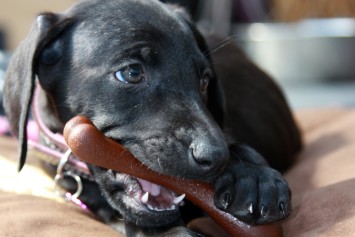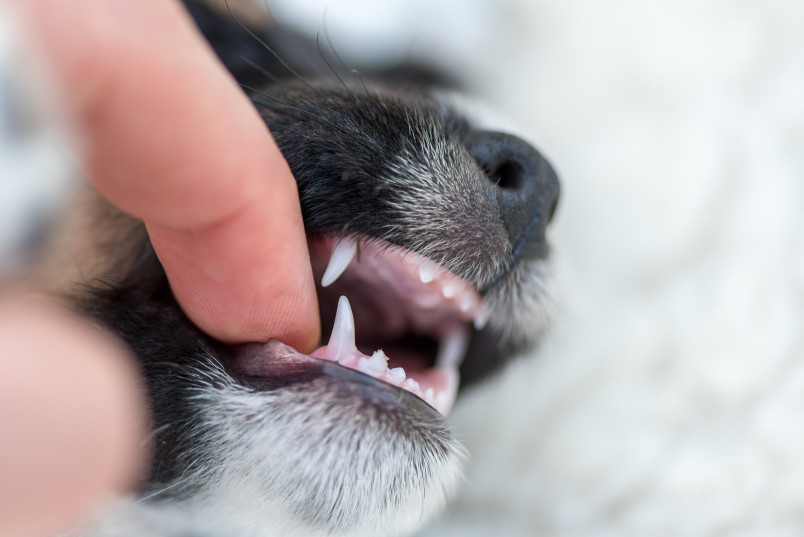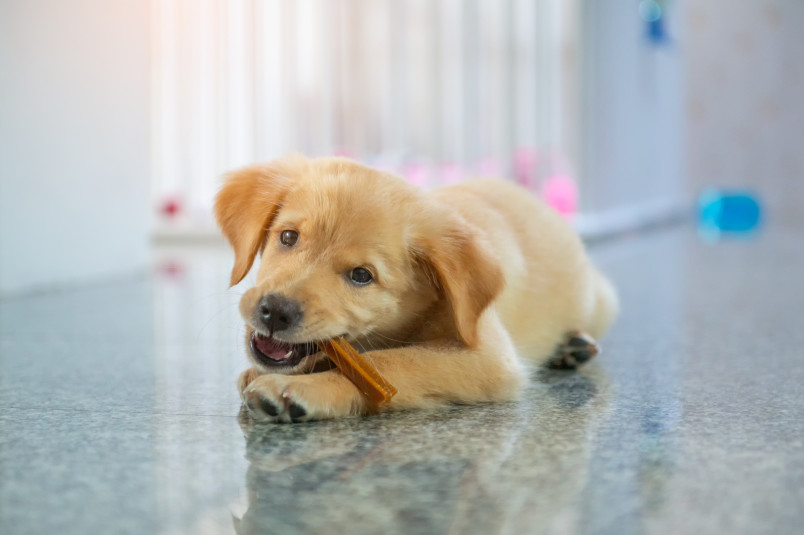
Bringing home a new puppy is a dream come true for many people. Fluffy fur, wagging tails, and puppy kisses - what's not to love? But then teething starts, and it can quickly turn into a nightmare. And not just teething, there's a lot of decisions and potential problems to worry about, like how long does it take for a puppy to get used to a new home?
Puppies chew on everything in sight when they're teething. Furniture, shoes, clothes, your hands - nothing is safe. And it's not just the destruction that's frustrating. Teething puppies can also be drooly, whiny, and irritable.
But don't worry, there's hope. Puppy teething is only temporary. And with a little patience and preparation, you can help your puppy through this stage without losing your mind.
Puppy Teething Timeline
Just like humans, puppies are born with a set of deciduous teeth, also called “milk” or “baby” teeth, that are eventually replaced by permanent adult teeth. Baby teeth in puppies can be surprisingly sharp, but thankfully, they don’t last for too long. Unlike humans, puppies normally only retain their baby teeth for a few months.
Do Puppies have Baby Teeth?
There can be some variation due to size or breed, but puppy teeth usually start erupting at around 2 weeks of age. By about 8-10 weeks old, most puppies have a full set of baby teeth and by 16 weeks teething has usually begun. Teething refers to the process by which the adult teeth begin to erupt through the gum and push out the smaller baby teeth. Understandably, this can be an uncomfortable process and can result in excess drooling, mildly decreased appetite or energy and even mild oral bleeding. Destructive chewing behavior will often get a lot worse during this time. If you notice any more severe symptoms, such as extreme loss of appetite, low energy, pain during eating, or your puppy throwing up please seek veterinary care.
When do Puppies Lose their Baby Teeth?
Puppies typically start losing their baby teeth around 4 months old, and most will have lost all of their baby teeth by 6 months old. However, there is some variation between breeds and individual puppies. Smaller breed dogs may take longer to lose their baby teeth than larger breed dogs.
If your puppy still has baby teeth by 7 months old, you should take it to the veterinarian for a checkup. The veterinarian can check to make sure that the adult teeth are coming in correctly and that there are no retained baby teeth.
Retained baby teeth are teeth that do not fall out when the adult teeth come in. This can happen for a number of reasons, such as if the adult tooth is not positioned correctly or if the baby tooth is still attached to the jawbone.
Puppy Dental Care
Just because your puppy’s baby teeth will fall out, doesn’t mean you should wait to start taking care of them. The time before teething is important for socialization and training; getting your puppy comfortable with being touched around the mouth and face at a young age will help desensitize them for the future.

This is also a great time to get your puppy used to tooth brushing! Dental care is an important component of a dog’s complete health maintenance routine. Dental disease is very common in dogs and can lead to many problems including infection, facial abscesses, oral bleeding, pain, and systemic inflammation when bacteria from the mouth enters the blood stream. Not to mention bad breath!
Start with Puppy Tooth Brushing
Tooth brushing is the gold standard for maintaining the health of your dog’s teeth but since it needs to be done at least every other day to be effective, training them early is the key to making this a lifelong habit. It only takes a day or two for bacteria to form calcified tartar on the outside of a tooth. Once this occurs, it is almost impossible to remove without professional intervention.
The physical act of brushing prevents the bacteria from adhering to the tooth but has to be done with regularity. A toothbrush made specifically for dogs is a great tool since the heads are angled and made to fit in a dog shaped mouth. Finger brushes or even dental wipes are other great alternatives. The action of abrasion against the tooth is most important but using an enzymatic toothpaste can have some added benefits and these are often flavored which also helps positively acclimate your puppy to the process. There are many videos online that show the steps involved in training your pup to brush, but the key is patience and positive reinforcement.
Other Dental Care Products for Puppies
We veterinarians are well aware that not all dogs are amenable to this process. Sometimes, the stress of trying to brush their teeth is too much for them. In these cases, there are other ways to maintain dental health. Most veterinarians recommend products that have been evaluated by the Veterinary Oral Health Council (VOHC) which is a group of board-certified veterinary dentists that evaluate dental products for their efficacy. You can think of it as the equivalent of the American Dental Association (ADA) for humans. These are products that have been tested and shown to eliminate plaque, tartar or bacteria in the mouth. The list includes several dental diets, chews, oral gels, powders and water additives that are safe and effective.

Don’t Let Your Puppy Teethe on Anything Too Hard!
Most dental disease is caused by tartar and bacteria, which you can help prevent with good dental care. However, fractured teeth can also lead to similar problems. Large dogs, in particular, tend to be avid chewers and allowing this behavior is important for their dental AND mental health. It is logical to think that giving a dog something hard to chew will help satisfy their needs but in fact it can pre-dispose a dog to dental fractures. Veterinary dentists usually recommend the thumbnail test – if you cannot dent a chew or toy with your nail, it is too hard. Slightly softer toys not only prevent fractures, but they actually help the tooth to sink into the item while a dog chews, scraping bacteria and softer plaque off the tooth surface, making it more effecting at cleaning.
There are so many great products available and using them can do a lot to maintain your dog’s oral health as puppies and adults. Unfortunately, the genetic makeup of your dog will also affect how likely they are to develop dental disease and just like people, even dogs with the strictest dental routine sometimes need a dental cleaning or procedure. This is a process that should be done under anesthesia and only by a veterinarian or board-certified veterinary dentist. Getting dog pet insurance while your puppy is young and healthy is a great way to offset the cost of unexpected dental emergencies, especially when an unexpected fracture or infection occurs. And an add-on canine wellness plan can even reimburse you for the costs of preventative care, like those dental cleanings. We strongly recommend researching available plans before committing to bringing a puppy into your home so you can be as prepared as possible for anything that might happen!
Be Careful with Gums During Dog Teething
Another important reason to start dental care early is that once teething begins, the gums can become irritated and sensitive. If you try to start brushing or touching the mouth during this time your puppy may start to associate the process with pain and become averse to it. It is usually recommended to pause any oral care during this time and restart once the adult teeth have mostly erupted (between 16 and 22 weeks). To maintain the training you have already done, offering some licks of toothpaste off the brush a few times a week will help keep the association going without causing any discomfort. Once teething is over you can return to normal brushing.
Aggressive Chewing when Teething
During the teething period, puppies often become “mouthy.“ Chewing is an entirely normal behavior, it is how they interact with and learn about their environment. While teething, it can even help ease some of the discomfort of the gums. Unfortunately, shoes, furniture and other items can often become unwitting victims of destruction during this time. Luckily there are several ways this can be avoided.
Puppy proofing your home by removing access to things like shoes, socks, human toys, etc. is the most direct way of both keeping your puppy safe and sparing your belongings. Puppies learn very quickly, however, so if they do get a hold of something, providing a distraction is another great way to teach a young dog what is appropriate to chew. If a puppy is noshing on something it shouldn’t, replacing it with a chew toy or treat dispenser (such as a Kong® toy filled with some of their kibble) can help redirect their energy. It is important to choose an appropriate soft toy as puppy teeth can be very delicate and break easily, in some cases leading to infection.
Putting chew toys in the freezer for a few hours can help a teething puppy by providing some relief for irritated gums. Avoid hard bones, antlers, rawhides and anything that is not obviously soft and flexible and always monitor them when they have a toy in case of choking. A puppy is also never too old to start learning. Practicing the “leave-it” or “trade” command can be very helpful for retrieving items in a positive manner without confrontation.
Puppy Teeth aren't the End of the World!
By providing alternate chewing options you are allowing your puppy to continue a natural and helpful behavior as well as keeping them safe and avoiding unwanted damage. While teething can be a “sore” subject, it is manageable and luckily a brief time in their lives. Don’t forget, early and regular dental care is very important. Developing a routine is a great way to bond with your puppy as well as keep them happy and healthy as they grow—and prevent future trips to the vet!